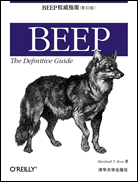
BEEP权威指南(影印版)
出版时间:2002年11月
页数:224
如果你需要设计一个非常适合你的应用程序的协议,你需要的就是BEEP ── 一种构造块的完整的集合,可以提供从设计构架到安全性等各种任务的最佳的解决方案。不管你是在编写简单的“取装型”的客户/服务器应用程序,还是在编写多线程的对等式中继系统,BEEP都提供了必要的功能而不需要额外的开销。
本书展示了BEEP的用途,更重要的是展示了怎样使用BEEP。在说明了BEPP协议的概念之后,本书还展示了怎样在Java、C和Tcl中使用BEEP的实现方式。相关的章节中建立了几个使用BEEP作为传输协议的实际应用程序,包括一个可靠的SYSLOG协议的实现方式和一个用于SOAP的BEEP传输协议的实现方式。
BEEP可以满足网络开发人员长远的需要,它提供了一个用于快速和方便地建立协议的标准的工具包。它第一次实现了下述目标:创建一个可以精密调整来满足应用程序需要的应用程序协议,从而可以避免重复劳动。如果你是网络开发人员,就必须熟悉这个重要的新工具。
虽然BEEP在2001年才标准化,但是它已经被各种小组用于SOAP交换、入侵检测、瞬时消息传送、网络监听、远程日程安排和安全证书交换等。虽然,这些小组在处理不同的问题,但是,他们共同的希望是能够集中处理“问题域”而不是协议管理的烦琐细节。
Marshall T.Rose是BEEP的创始人,负责多种Internet标准技术的设计、规范和实现。他还是60多种Internet的Request for Comments(RTF)系列(包括POP和SNMP)的作者。
本书由Carl Malamud作序。
本书展示了BEEP的用途,更重要的是展示了怎样使用BEEP。在说明了BEPP协议的概念之后,本书还展示了怎样在Java、C和Tcl中使用BEEP的实现方式。相关的章节中建立了几个使用BEEP作为传输协议的实际应用程序,包括一个可靠的SYSLOG协议的实现方式和一个用于SOAP的BEEP传输协议的实现方式。
BEEP可以满足网络开发人员长远的需要,它提供了一个用于快速和方便地建立协议的标准的工具包。它第一次实现了下述目标:创建一个可以精密调整来满足应用程序需要的应用程序协议,从而可以避免重复劳动。如果你是网络开发人员,就必须熟悉这个重要的新工具。
虽然BEEP在2001年才标准化,但是它已经被各种小组用于SOAP交换、入侵检测、瞬时消息传送、网络监听、远程日程安排和安全证书交换等。虽然,这些小组在处理不同的问题,但是,他们共同的希望是能够集中处理“问题域”而不是协议管理的烦琐细节。
Marshall T.Rose是BEEP的创始人,负责多种Internet标准技术的设计、规范和实现。他还是60多种Internet的Request for Comments(RTF)系列(包括POP和SNMP)的作者。
本书由Carl Malamud作序。
- Foreword
- Preface
- 1. Introduction
- Application Protocol Design
- The Problem Space
- The IETF and BEEP
- beepcore.org
- How This Book Is Organized
- 2. Concepts
- Sessions
- Channels
- Exchanges
- Messages
- Packet Formats and Traces
- 3. Tuning
- The Greeting
- Channel Management
- The TLS Profile
- The SASL Family of Profiles
- Tuning in Practice
- Tuning Profiles Versus Exchange Profiles
- The Lifecycle of a Session
- 4. Exchanges
- Client/Server
- Server/Client
- Peer-to-Peer
- Let's Recap
- 5. BEEP in Java
- A Guided Tour
- Fundamental Classes
- 6. BEEP in C
- A Portable Implementation
- Echo and Sink
- Reliable Syslog
- 7. BEEP in Tcl
- Introduction to Tcl SOAP
- Adding BEEP Support to the Client
- Adding BEEP Support to the Server
- 8. Futures
- Experiences
- Stability and Evolution
- Tunneling
- Transport Mappings
- Finally
- Appendix: On the Design of Application Protocols
- References
- Index
书名:BEEP权威指南(影印版)
作者:Marshall T. Rose 著
国内出版社:清华大学出版社
出版时间:2002年11月
页数:224
书号:7-302-05983-7
原版书出版商:O'Reilly Media
The animal on the cover of BEEP:The Definitive Guide is a coyote, a name derived from the Aztec coyotl. Its Latin name, Canis latrans, means "barking dog"-a tribute to its reputation as one of the most vocal mammals in North America. The coyote howls and yips to communicate with family members and to signal its presence to other coyotes. The coyote is the most widely distributed large predator in North America. Its amazing adaptability has led to the coyote's being one of the few mammals whose range is increasing in spite of human encroachment. Although a native of the American desert and plains, the coyote's range now includes Alaska's North Slope, the Guatemalan highlands, and the forests of New England. Extermination of the wolf in central and northern America significantly aided the coyote's spread.
The coyote's eating habits are as versatile as its habitats. Primarily carnivorous (90% of their diet), coyotes consume large amounts of carrion if fresh meat isn't available. They also eat birds, snakes, leaves, seeds, fruits, vegetables, and garbage.
Coyotes are intelligent and wily hunters. They sometimes form "hunting partnerships" with the badger-he coyote locating rodents with its keen sense of smell and the badger digging them up with its powerful claws. The partners then share the catch.
The coyote continues to threaten livestock herds, as well as family pets.On the other hand, with pelts valued at about $17 each, coyotes face even greater threats from hunters.
The coyote's eating habits are as versatile as its habitats. Primarily carnivorous (90% of their diet), coyotes consume large amounts of carrion if fresh meat isn't available. They also eat birds, snakes, leaves, seeds, fruits, vegetables, and garbage.
Coyotes are intelligent and wily hunters. They sometimes form "hunting partnerships" with the badger-he coyote locating rodents with its keen sense of smell and the badger digging them up with its powerful claws. The partners then share the catch.
The coyote continues to threaten livestock herds, as well as family pets.On the other hand, with pelts valued at about $17 each, coyotes face even greater threats from hunters.
购买选项